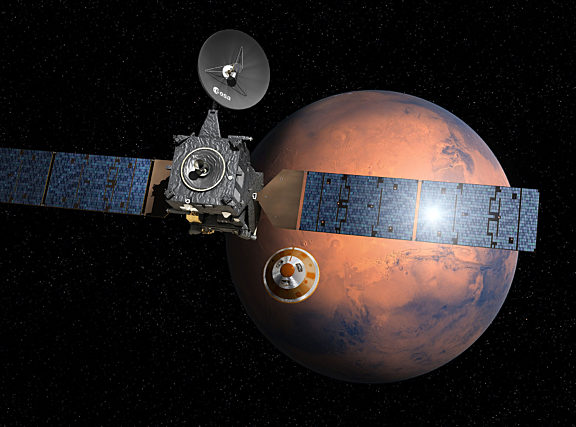The ExoMars Trace Gas Orbiter, mapping Mars’ atmosphere
Highlights
- The ExoMars Trace Gas Orbiter, a collaboration between the European Space Agency and the Russian space agency Roscosmos, launched in March 2016 and arrived at Mars later that year.
- It dropped off a lander named Schiaparelli, but the lander’s parachutes deployed too early and crashed.
- The orbiter is characterizing gases in the Martian atmosphere and looking for hints of life.
What is the ExoMars Trace Gas Orbiter?
The ExoMars Trace Gas Orbiter, or TGO, was launched to Mars in March 2016. It was originally intended as a collaboration between the European Space Agency (ESA) and NASA, but after NASA dropped out of the project in 2012, the Russian space agency Roscosmos stepped in to provide a Proton-M rocket to launch the spacecraft and help develop some of its scientific instruments.
TGO carried the Schiaparelli lander with it to Mars, but after the spacecraft’s seven-month journey, the dropoff did not go as planned. Instead of landing gently on the planet’s surface, Schiaparelli’s parachutes deployed too early and it crashed to the ground. All was not lost for the mission, though — the orbiter reached its final altitude of 400 kilometers (248.5 miles) above the surface in 2018 and has continued to observe Mars since then.
As the name of the mission suggests, TGO was designed to look for traces of various gases and molecules in Mars’ carbon dioxide-dominated atmosphere. These substances include carbon monoxide, hydrogen, and methane. The search for methane is particularly important, as its presence could potentially be a sign of life because it is commonly produced by microbes on Earth. The orbiter’s sensitivity to hydrogen has also allowed it to search for water buried underneath shallow layers of Martian soil.

How the ExoMars Orbiter works
The spacecraft itself is a 3.2 meter (10.5 foot) by 2 meter (6.6 foot) by 2 meter box, fitted with one antenna to communicate with Earth and another to communicate with spacecraft on the surface of Mars. It is powered by a pair of solar arrays that protrude from its sides like wings, along with two small batteries to keep it running during eclipses, when it doesn’t receive any sunlight.
Inside the box are four science instruments designed to examine the Martian atmosphere and the top meter of its crust. The first, the Nadir and Occultation for Mars Discovery (NOMAD), is designed to examine the components of the thin atmosphere, as well as where they come from and how they dissipate away to space, by looking through the air towards the sunset and sunrise over the edge of the planet. The Atmospheric Chemistry Suite (ACS) is also a spectrometer, covering different wavelengths of light from NOMAD for a more complete idea of the atmospheric makeup. The Fine-Resolution Epithermal Neutron Detector (FREND) looks for neutrons that hint at the presence of hydrogen — and therefore water — in the top meter of Martian soil. Finally, the Colour and Stereo Surface Imaging System (CaSSIS) is a small telescope with a high-resolution camera to take pictures of the surface and build a map of the topography.
TGO also has a telecommunication system that can receive data from landers and rovers on the planet’s surface and relay it back to Earth. This radio system is specifically designated to help the upcoming Rosalind Franklin rover return data to Earth.

Major discoveries so far
While hunting for methane is one of TGO’s main goals, it unexpectedly has not found any yet, placing limits on the amount of Martian methane that are significantly lower than previous estimates. This is in contrast to data from the Curiosity rover and the Mars Express orbiter, both of which have detected sporadic bursts of methane that TGO didn’t see, even when it specifically looked in the area just over Curiosity. It also hasn’t found any hints of other gases that could be signs of life, such as phosphine.
That doesn’t mean that its search for atmospheric gases has been in vain, though. It has made detailed maps of the carbon monoxide and water vapor in the atmosphere, along with several other molecules. The maps of water vapor demonstrated how dust storms on Mars affect the atmosphere, lofting water and ice high into the air.
The spacecraft also made the most detailed maps of ice buried just below the Martian surface, giving clues as to the history of the planet’s climate. These maps demonstrated that there may be far more accessible ice on Mars than researchers had previously realized.
Support Missions like the ExoMars Trace Gas Orbiter
Whether it's advocating, teaching, inspiring, or learning, you can do something for space, right now. Let's get to work.


 Explore Worlds
Explore Worlds Find Life
Find Life Defend Earth
Defend Earth


